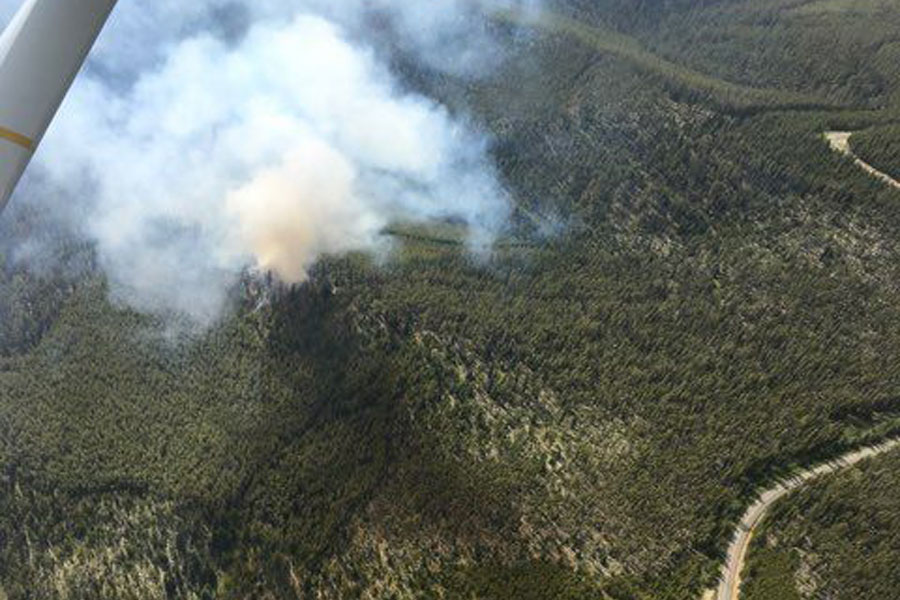Forest Managers Propose Emergency Thinning Project to Reduce Wildfire Risk near Eureka
As wildland fires grow in intensity, land managers aim to reduce hazards on the wildand urban interface through fuels-reduction work and forest thinning
By Tristan Scott
As residential populations flanking the Kootenai National Forest expand, and as wildland fires grow in intensity due to climate change, land managers are proposing new strategies to improve forest health and reduce the risk of wildfire in northwest Montana’s Lincoln County, where thousands of forested acres have been identified as high-risk firesheds eligible for emergency intervention.
The latest example of this is the Glen Sinclair Fuel Reduction Project on the Kootenai National Forest’s Rexford and Fortine Ranger Districts near Eureka, where District Ranger Seth Carbonari is proposing vegetation and prescribed fire treatments as part of a mitigation strategy to “reduce the risk and extent of catastrophic wildfires to the communities, forests and infrastructure within the wildland urban interface of Lincoln County,” according to the scoping document, which is available here along with an interactive storymap. Forest managers are seeking public feedback as they review the project under the National Environmental Policy Act’s (NEPA) categorical exclusion rule, which is a less intensive category of analysis preceding agency action than, for example, an Environmental Assessment, which often requires an Environmental Impact Statement.
The specific mechanics of the Glen Sinclair project involve treating forested parcels spanning 3,000 acres of federal lands in the Kootenai National Forest, one of 10 priority landscapes identified by a 2022 U.S. Forest Service initiative called the Confronting the Wildfire Crisis Strategy. The broader Kootenai Complex has also been designated as a priority for restoration in the Montana Department of Natural Resources and Conservation’s (DNRC) Forest Action Plan, as well as for hazardous fuels reduction in Lincoln County’s Community Wildfire Protection Plan.

“This strategy is focused on reducing wildfire risk by treating the right landscapes at a scale needed to sustain and restore healthy, resilient fire-adapted forests,” according to Carbonari’s scoping letter, which characterizes the project as having gained urgency since the DNRC’s 2020 Montana Wildfire Risk Assessment. That assessment “determined that a wildfire within the project area would present an extreme risk to people, property and critical infrastructure in the communities of Eureka and the Glen Lake Area.”
To mitigate that risk, the Forest Service has applied to have the Glen Sinclair project classified for emergency action under the 2022 Infrastructure Investment and Jobs Act (also known as the Bipartisan Infrastructure Law), which authorizes the Secretary of Agriculture to declare that an emergency exists and that the action is “necessary to achieve relief from hazards threatening human health and safety or mitigating threats to natural resources on National Forest System or adjacent lands.”
Based on the risks outlined in the Forest Service’s January 2022 Wildfire Crisis Strategy, U.S. Agriculture Secretary Thomas J. Vilsack determined that an emergency exists on 250 high-risk firesheds in the western United States, including the Kootenai Complex.
“Over the past decade wildland fires have increased in size and severity in Lincoln County. This trend is expected to worsen as climate change results in lighter snowpacks, higher summer temperatures, lower humidity and earlier snowmelt that will create longer periods in which fuels are dry and primed to burn,” according to the scoping document. “A century of fire exclusion has also created denser forests with increased abundance of trees less resistant to fire, accumulations of ground and ladder fuels, and increased tree mortality from disease and inspect outbreaks. Under these forest conditions, wildfires are more likely to spread to the canopy, where they burn at higher intensity, and are more dangerous and harder to contain.”
As of Feb. 1, the snow-water equivalent (SWE) in the Flathead River Basin was 66% of normal, while the Kootenai basin reached 67%. SWE is the measurement used to gauge the amount of liquid water released when the snowpack melts, and can predict dry forest conditions in the summer months.

The proposed project area is spread out across 7,190 acres in the Glen Lake, Sinclair Creek, and Ksanka foothills areas in Lincoln County, northeast of Highway 93 and next to the community of Eureka. The area is also popular among forest users for dispersed camping, fishing, hunting, hiking and scenic driving.
The proposal calls for the construction of approximately 122 acres of fuelbreak alongside Forest Service Road 756 (Foothill Road) and on private property within the Ten Lakes Contiguous Inventoried Roadless Area, which is part of the Ten Lakes Wilderness Study Area. Those treatments would be completed by hand, according to the proposal, requiring no excavators or other off-road equipment. Slash would be piled by hand and then burned.
Development of the Glen Sinclair project began in 2022 with initial field reconnaissance by a Forest Service planning team, which used field data to refine the proposed action.
About 63% of the area is dominated by Douglas-fir, with western larch forests accounting for about 29%. Ponderosa pine, lodgepole pine, and spruce are also present on the landscape, but are less dominant. Under the historic fire-suppression regime favored by the federal agency for decades, the forest has undergone “a gradual conversion of species composition across the project area resulting in increased abundance of tree species that are more vulnerable to drought, insects and diseases, and less resistant to fire.”
“We also seek to create conditions that allow for safe and effective wildfire management, lower the risk of epidemic levels of insect and disease, and provide a sustainable flow of forest products,” the scoping letter states.
Carbonari said public comments will help inform project development during the NEPA process and would be most helpful if received by March 6.
Forest officials and resource specialists will host an open house to share thoughts and concerns on Thursday, Feb. 15 from 5 p.m. to 6:30 p.m. at the Glacier Bank Community Room, 222 Dewey Ave., Eureka.
The full proposal with activity descriptions and maps is available online at: https://www.fs.usda.gov/project/?project=65290